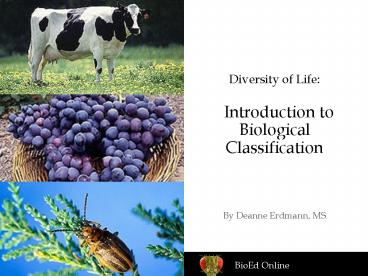Diversity of Life: Introduction to Biological Classification - PowerPoint PPT Presentation
1 / 31
Title:
Diversity of Life: Introduction to Biological Classification
Description:
Diversity of Life: Introduction to Biological Classification By Deanne Erdmann, MS BioEd Online * Image References Weller, K. Dairy Cow. USDA Agricultural Research ... – PowerPoint PPT presentation
Number of Views:611
Avg rating:3.0/5.0
Title: Diversity of Life: Introduction to Biological Classification
1
Diversity of Life Introduction to
Biological Classification
- By Deanne Erdmann, MS
2
Why Do We Classify Organisms?
- Biologists group organisms to represent
similarities and proposed relationships. - Classification systems change with expanding
knowledge about new and well-known organisms.
Tacitus bellus
3
History of the Kingdom System
- http//earthlingnature.wordpress.com/2011/12/05/a-
brief-history-of-the-kingdoms-of-life/
4
Classification
- Binomial Nomenclature
- Two part name (Genus, species)
- Hierarchical Classification
- Seven Taxonomic Categories
- Systematics
- Study of the evolution of biological diversity
Leucaena leucocephala Lead tree
5
Binomial Nomenclature
- Carolus von Linnaeus
- Two-word naming system
- Genus
- Noun, Capitalized, Underlined or Italicized
- Species
- Descriptive, Lower Case, Underlined or Italicized
Carolus von Linnaeus(1707-1778) Swedish
scientist who laid the foundation for modern
taxonomy
6
Hierarchical Classification
- Taxonomic categories
- Kingdom King
- Phylum Philip
- Class Came
- Order Over
- Family For
- Genus Good
- Species Soup
7
Kingdoms and Domains
The three-domain system
Bacteria
Archaea
Eukarya
The six-kingdom system
Bacteria
Archaea
Protista
Plantae
Fungi
Animalia
The traditional five-kingdom system
Monera
Protista
Plantae
Fungi
Animalia
8
SystematicsEvolutionary Classification of
Organisms
- Systematics is the study of the evolution of
biological diversity, and combines data from the
following areas. - Fossil record
- Comparative homologies
- Cladistics
- Comparative sequencing of DNA/RNA among organisms
- Molecular clocks
9
Taxonomic Diagrams
Mammals
Turtles
Lizards and Snakes
Crocodiles
Birds
Mammals
Turtles
Lizards and Snakes
Crocodiles
Birds
Cladogram
PhylogeneticTree
10
http//evolution.berkeley.edu/evolibrary/article/p
hylogenetics_02
11
Dichotomous Keys Identify Organisms
- Dichotomous keys versus evolutionary
classification - Dichotomous keys contain pairs of contrasting
descriptions. - After each description, the key directs the user
to another pair of descriptions or identifies the
organism. - Example 1. a) Is the leaf simple? Go to 2 b)
Is the leaf compound? Go to 3 - 2. a) Are margins of the leaf jagged? Go to
4 b) Are margins of the leaf smooth? Go to 5
12
Dichotomous key
- http//www.classzone.com/cz/books/bio_09/resources
/htmls/animated_biology/unit7/bio_ch21_0657_ab_tre
e.html
13
(No Transcript)
14
Plant Phyla
- bryophyta
- Filicinophyta
- Coniferophyta
- Angiospermophyta
15
Bryophyta (bryo- moss)
- mosses, liverworts and hornworts
- stems radial symmetry (mosses)
- stems bilateral symmetry (liverworts), no lignin
- no true leaves or roots
- no cuticle.
- reproductive structure are called sporangium
which are on long stalks with capsules on end. In
this image the spore is released from the
sporangium to develop into another plant.
16
Filicinophyta (ferns)
- leaves
- roots non woody stems
- divided leaves
- height up to 20 m
- reproduction sporangia (sori) contain
reproductive spores
17
Coniferophytes (conifers and pines)
- trees (100m), shrubs,
- woody (lignin) stems,
- waxy narrow needle like leaves.
- vascular system (tracheids)
- reproduction monoecious, microsporophylls (male)
non motile gametes often with air bladders for
water/ air dispersal. macrosporophylls (female)
ovule on cone scale
18
Angiospermophyta (flowering plants and grasses)
- roots
- stems
- leaves.
- vascular bundles (xylem/ phloem )
- waxy cuticle,
- annual or perennial up to 100m
- reproduction
- ovules in an enclosed carpel structure.
- pollen grains produced from anthers
- variety of pollen transfers vectors
19
Animal Phyla (just the invertebrates for now)
- Porifera (sponges)
- Cnidaria (jellyfish)
- Platyhelminthes (flatworms)
- Annelida (segmented worms)
- Mollusca (snails, clams, octopus)
- Arthropoda (insects, crustaceans, spiders...)
20
(No Transcript)
21
(No Transcript)
22
(No Transcript)
23
(No Transcript)
24
(No Transcript)
25
(No Transcript)
26
(No Transcript)
27
(No Transcript)
28
(No Transcript)
29
(No Transcript)
30
(No Transcript)
31
(No Transcript)































